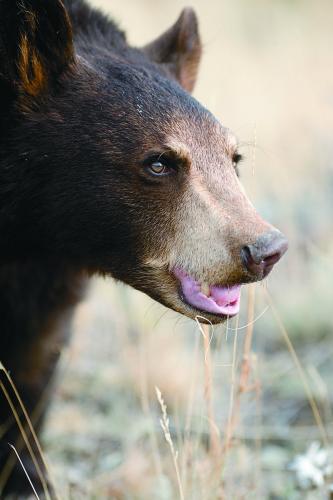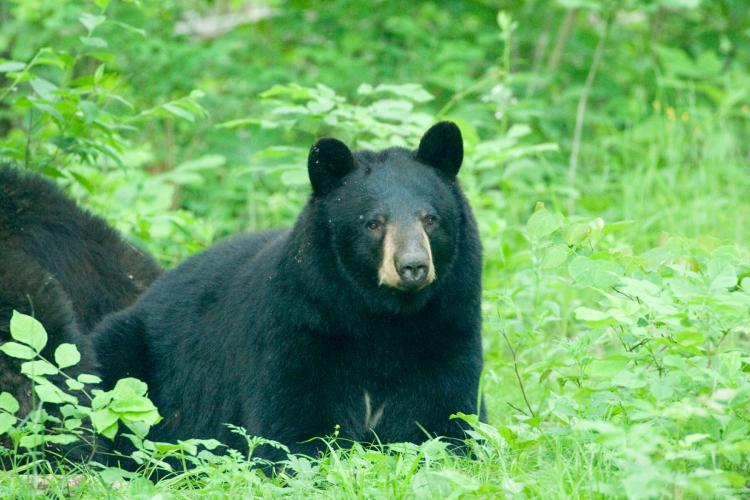
The American black bear is one of the largest and heaviest wild mammals in Missouri. It has a long muzzle with a straight facial profile; rounded, erect ears; rather short, stout legs; and a very short tail practically concealed in the long, heavy fur. For black bears in Missouri, the fur is predominantly glossy black; the muzzle is brown, and there is usually a white patch on the chest. The sexes look much alike, though females are usually smaller than males. Black bears are usually silent but can make a variety of sounds. they may grunt, mumble, squeak, roar, huff, bellow, hum, moan, or purr.
Total length: 46–78 inches; tail length: 4–5 inches; weight: 86–900 pounds.
Most Missouri bears live south of Interstate 44, but wandering individuals, mostly subadult males, have been seen as far north as the Iowa border. Black bears are the only bear species found in Missouri.
Habitat and Conservation
Black bears live in heavily wooded areas. In winter they den in a hollow tree, cave, an excavated hollow in the ground or another shelter. In summer they sleep in trees or on the ground. Black bears used to be abundant in the state but had become rare by 1850 and were nearly eliminated by 1931. Reintroduction efforts in Arkansas have increased their numbers in our state. Because a bear can become a danger when it learns to associate humans with food, it is important to keep them wild.
Food
Black bears eat a variety of foods. Plant matter includes grass, berries and other fruits, various seeds and nuts, the inner bark of trees and roots. Animal food includes ants, bees and their honey, crickets and grasshoppers, fish, frogs, small rodents, fawns, bird eggs, and many kinds of carrion. Acorns are an important food source in the fall as bears prepare for winter.
Status
Mostly extirpated from the state since the 1950s, black bears have been making a comeback. In 1958, Arkansas began reintroducing bears into that state, and sightings in Missouri increased beginning in the 1960s. A 2010 large-scale DNA study of Missouri's bear population suggests that our largest population, in south-central Missouri (Webster and Douglas counties), may represent a small remnant of that region’s historical population, combined with bears descended from the Arkansas releases.
Life Cycle
Mating is in May or June but the development of eggs is arrested for 6 or 7 months. The eggs continue development about the time that bears enter hibernation, in October or November. Young are born in late January or February — sometimes while the mother is still asleep. A litter usually has 2 or 3 cubs. Winter inactivity usually extends into April, when bears leave their winter quarters and feed heavily. Cubs stay with the mother through the summer and usually den with her the next winter.
Control
Human Connections
In the past, bear meat provided considerable food for Indians and white settlers, and bear fat was valuable for numerous uses. Bear fur was used for bedding, coats, and rugs.
Ecosystem Connections
Bears feed on smaller animals and thus keep their populations in check; they also kill old, injured, sick animals unfit to survive. As scavengers, they eat carrion and therefore help clean the woods.
Signs and Tracks

Front track:
- 3¾ inches long; size varies greatly between young and older individuals
- 5 toes
- Claws often do not show
- The separate heel pad sometimes doesn’t show.
Hind track:
- 8 inches long; size varies greatly between young and older individuals
- 5 toes, but smallest (inside) toe may not register
- The smallest toe is the one on the inside (analogous to our big toe), and it sometimes doesn’t leave a print.
- Often described as looking like the prints of a person wearing moccasins.
Other notes:
- Bears are becoming increasingly common in Missouri and are expanding their range. They are more common in the southern third of the state and generally prefer heavily wooded areas.
- The overall large size is perhaps the most important character for identification.
- The claws often leave marks in soft substrates.
- Distance between strides is 1 foot (walking); 3 feet (running).
- Pattern varies; bears can shuffle, walk, run, and gallop.
- Bears leave several distinctive marks on trees.
















































